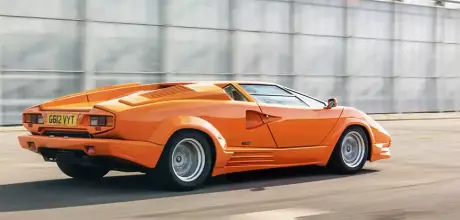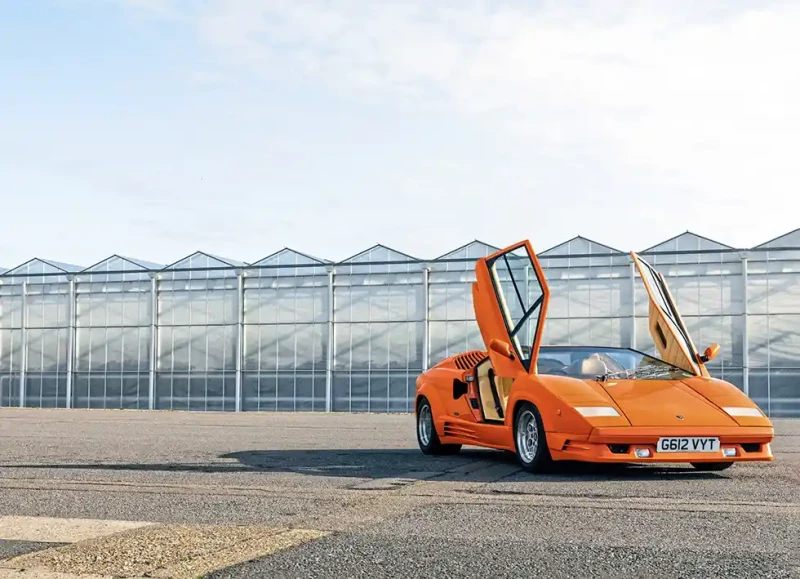1990 Lamborghini Countach 25th Anniversary
The Lamborghini Countach has lost none of its power to amaze. Today, 50 years on from its release, a drive in the last of the line draws all the threads of this landmark supercar together.
Words SAM DAWSON
Photography JONATHAN FLEETWOOD
SUPERCAR KING AT 50
Hitting the road in the definitive poster car
Eternal Extremist 50 years on, we celebrate the Lamborghini Countach
PLUS development driver Valentino Balboni on honing the definitive supercar
Countach at 50: still the definitive supercar
Eternal Extremist
The Lamborghini Countach is 50 years old. Half a century. The distance between its arrival and now is the same as that between the Wright Brothers’ first flying machine and the arrival of the swing-wing Grumman Jaguar fighter jet. And yet, after all these intervening years, I’m not sure any road car quite matches a Countach for sheer chill-down-the-spine, did-I-really-just-see-that shock value. Even today, most mid-engined supercars still look like Countach tribute acts to some degree. Build materials may change, performance figures may climb, but these are mere nudges of the dial. A look back through the American motoring press reveals that the muscle cars of the Sixties were the first to be dubbed supercars. Journalists grasped for terms to describe the preceding Miura, plumping for things like ‘dream-car’ (Autocar) and ‘Road-racer’ (Road & Track). But the second they got their hands on the Countach, the word ‘supercar’ truly found its meaning and the Detroit big-blockers were retrospectively remonikered. Everything about it was superlative. Even the name, a Piedmontese expletive with the same root as ‘contagious,’ uttered by a Bertone craftsman upon seeing the completed prototype, according to the car’s designer Marcello Gandini. There was simply no other way to describe it.
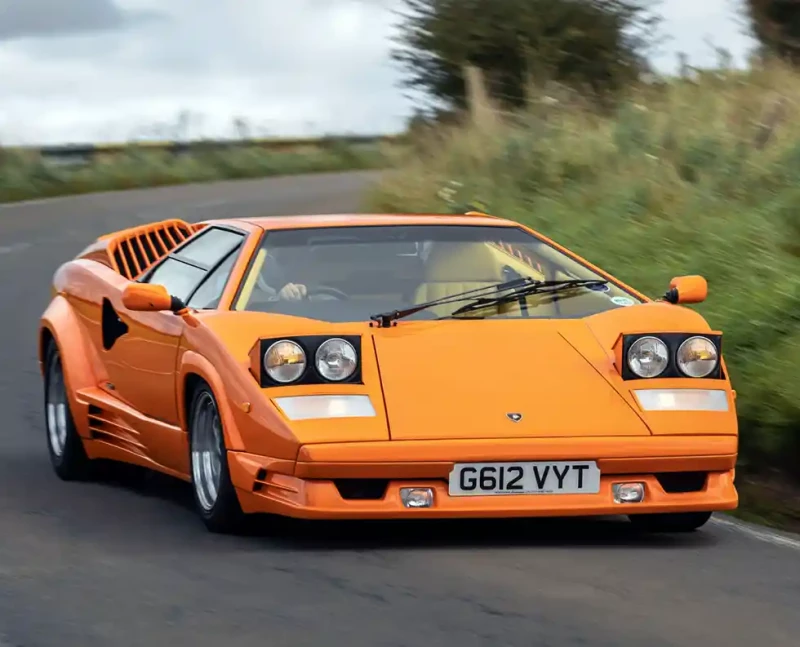
This particular Countach plays a unique visual trick as I approach it, ignition key in hand. As a 1990 25th Anniversary, it’s the ultimate Countach – polished, refined, more powerful and advanced than any before it. It may actually be the second-to-last ever built, although the Sant’Agata factory’s build records were notoriously inaccurate back then.
However, that orange hue is pure Seventies. Most 25ths were finished in bold but passé Eighties primary shades, but this one’s then-unfashionable paint is reminiscent of the innards of an Eero Aarnio Globe chair or an early Flymo. The kind of defiantly artificial-looking colour the Seventies decided the future would be finished in. This car’s first owner had an original Countach LP400 in orange and politely requested that the factory finish one of the last for him in a matching colour. In obliging, Lamborghini created something unique. Immediately hidden in a private collection, it first emerged onto the concours scene last year in incredible barely-used condition. Just for today, this – the closest you can get to a brand new Countach – is mine.
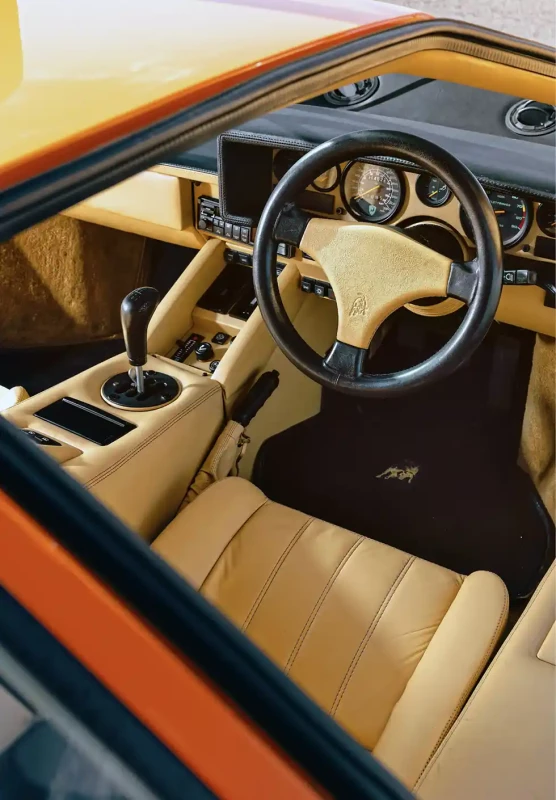
Getting in isn’t as difficult as it looks. Negotiating a Lotus Esprit, with its wider sills, is much harder. But there’s still a trick to it. On this right-hand drive Countach, you put your left foot in first, under the small steering wheel, before descending into the driver’s seat, swinging your right leg over the sill afterwards. Once inside, everything feels serious, hard and unyielding as I get acquainted with a dry run through the controls, from the firmness of the banana-shaped seat’s padding to the pedal weights, and the force needed to move the stiff gear lever and unassisted steering. It seems odd that a car supposedly not intended for motor sport seems set to punish its driver compared to apparently more ‘serious’ and race-bred yet relatively easygoing opposition from Ferrari and De Tomaso.
‘Pagani brought in World Rally Champion Sandro Munari to fine-tune the chassis’
But this, as we shall see, is a misconception. The Countach, especially in this ultimate form, was supposed to be every bit the road-racer as anything from Maranello.

Turn the ignition key, and there’s a quick snarl as 12 cylinders thunder into life. But it isn’t long before the mighty V12 settles to a surprisingly muted idle, the sound of its six downdraught Weber 44DCNF carburettors lazily gobbling air more reminiscent of a Sixties American muscle car with a Holley four-barrel ticking over than something handbuilt and highly-strung.
Because of the sheer physical effort needed to drive a Countach, I’m naturally cautious to the point of intimidation about getting it off the line. And yet, the inherent smoothness of the V12’s configuration soon makes itself felt. There are no sudden jerks, no unevenness. The car rockets away with the low growl of a wakening guard dog. Once shifted out of first gear, away from reverse with its racer-style lockout and into the second-to-fifth H-pattern, the short-shifting gearbox reveals itself to be slicker and more user-friendly than the gym-heavy clutch suggested. However, the Countach’s unusual layout, with the gearbox mounted in front of the V12’s block and the bellhousing by my left elbow rather than hanging out at the back like most of its rivals, avoids the convoluted linkage and vague shift most supercars of this era struggle with. Once you anticipate the clutch weight, you can change gear quickly.

Also direct-feeling is the steering. It never relinquishes its weight, manoeuvring the hefty front 225/50 VR15 tyres requires shoulder input rather than the delicate wrist-flicks that can navigate a Berlinetta Boxer or Testarossa. And yet, there’s reassurance here. You can put a huge amount of faith in the grip of those tyres – the rear 345/35 VR15s especially – and this combination of intense workout-level physicality combined with tenacious, faithful grip instantly puts me in mind of karting. Despite the near total lack of rear three-quarter visibility, the Countach is actually a relatively small car you can genuinely hurl around, using the angular corners of the windscreen to position it between apexes.
And yet the Countach story is one of tyre technology as much as anything else. Collectors and onlookers may coo over the apparent purity of the LP400, and there is much to admire in Gandini’s original. The shape was first seen in prototypic form as the Carabo, Bertone’s 1968 concept car based on the Alfa Romeo Tipo 33 Stradale, its name and iridescent green colour referencing the carabidae beetle. It may have been an Alfa beneath but all the Countach elements are present in the Carabo, from the double row of headlight apertures and extreme wedge shape to the insect-wingcase doors. Gandini, a musician and artist never formally trained as a car designer, often locked himself in his studio at this time, escaping the persistent intrusions of boss Nuccio Bertone, never asking others for their opinions and cleansing his mind of all conventional automotive influence. This process generated both the Carabo and Countach, the only real requirement of which, beyond clothing Paolo Stanzani’s mechanical package, was to use wedge aerodynamics to avoid the lift that had plagued its predecessor, the more conventional-looking, transverse-engined Miura.
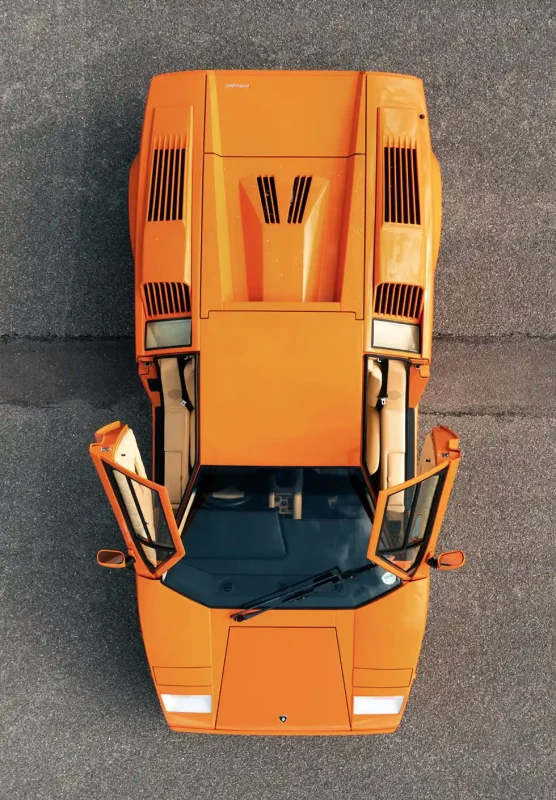
Within this lightest of briefs, Gandini had free reign. But there was another problem to overcome. The Miura might have won the world’s adoration in 1966, but it was starting to become something of a headache for Lamborghini. At £8050, it was top-end Mercedes or Porsche 911 2.7RS money, and a relatively high-volume 741 had been built in its eight-year life. But the second-hand market was unsure how to treat it, garages were baffled by it, and depreciation had been severe. In Italy, Fiat drivers in nose-to-tail autostrada jams would often discover an expired Miura with an out-of-their-depth young poseur-driver as the cause of the holdup. As with the last days of the Jaguar E-type in the UK, the Miura had rapidly lost its lustre. And as the Countach neared market-readiness, the global oil crisis poleaxed big-engined car sales. Ferruccio himself lost interest, and sold his stake in his eponymous firm to René Leimer. Lamborghini needed something to sell, and fast. Problem was, the Countach simply wasn’t ready. It had been designed around experimental Pirelli tyres which weren’t commercially available yet, and so ended up rushed into market with the fastest speed-rated wheels and rubber that Lamborghini could get its hands on, Michelin XWXs on Maserati Ghibli rims. I have driven an LP400, and the combination of a scarily light back end at speed, combined with surprising roll angles brought about by the sidewall compression of tyres designed for big GTs, puts the experience a world away from the comprehensive, slick package offered by this 25th Anniversary.
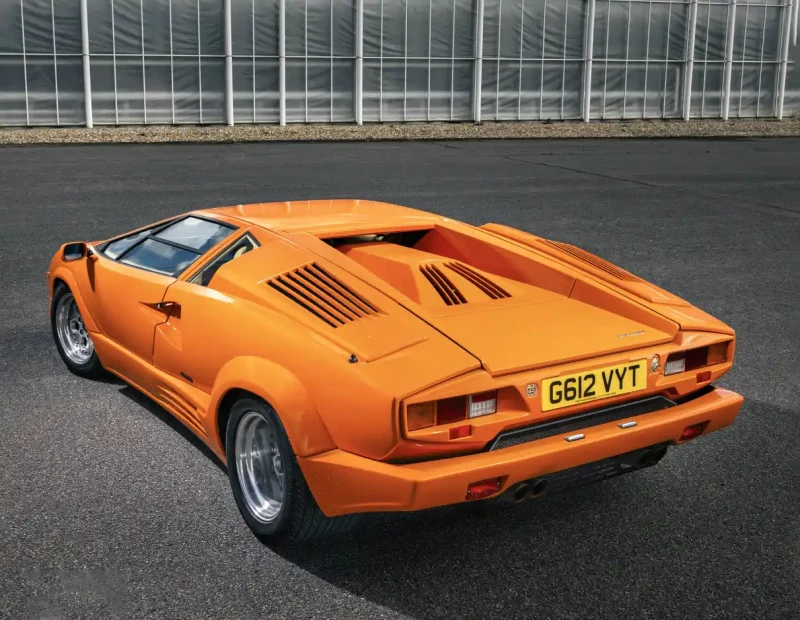
But what the Countach also did was create an entirely new stratosphere for supercars to inhabit. The LP400 was priced at a gobsmacking £18,295 in 1974, a full £1000 more than a Ferrari Berlinetta Boxer and a staggering £4000 clear of a Porsche 930 Turbo – a price difference that would have bought a Jaguar XJ6 with the change. Half the production rate of the Miura, plus the straitening effects of the oil crisis, meant the Countach never really fell into the hands of people who couldn’t afford to run one in the way Miuras had.
This orange car’s initial journey straight from Sant’Agata to air-conditioned warehouse was typical of the model throughout its life. As I pass rubbernecking onlookers negotiating the A286, I remember the world the Countach inhabited when I was a Matchbox petrolhead. Everyone had a toy one, probably a poster as well. Thanks ironically to the Mirage kit-car replica bodyshell, covertly moulded in glassfibre from a real one in a derelict Manchester mill in 1982, they appeared in plenty of Hollywood action film stunts, glimpsed on past-bedtime telly.
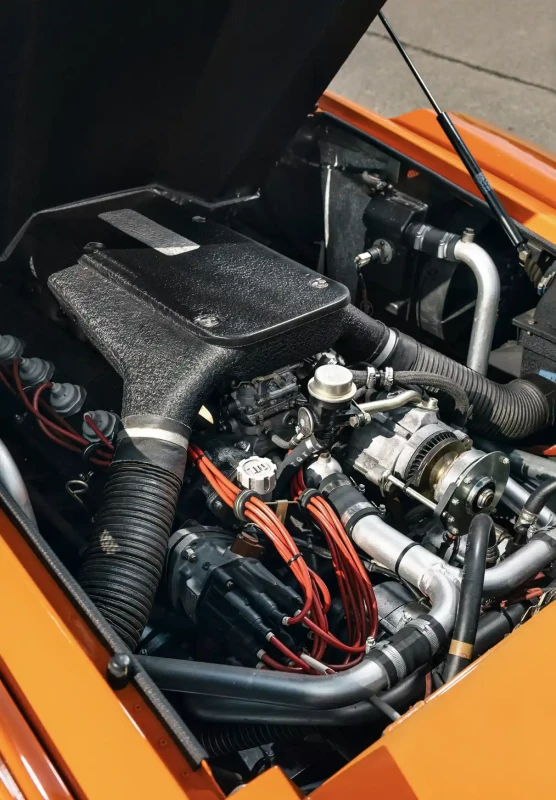
But you never actually saw a Countach in real life, until perhaps one fateful night on a long motorway journey, or a rare foray into some upmarket part of town. A white missile closing on your repmobile at dizzying speed. A strident shriek away from the kerb with a snatched glimpse of trapezoidal taillight. A quick glance was all you were getting. And then you’d tell everyone you knew about it.
The one on your poster, or the toy you pushed around the carpet, inevitably had a gigantic rear delta-wing though. This one doesn’t, and it’s faster for it. The wing was just an aftermarket part fitted in the Sant’Agata car park by the same firm that screwed them to De Tomaso Panteras half an hour down the road in Modena. The drag it generates knocks 10mph off the top speed. And yet, it was part of an F1-inspired package devised by Gianpaolo Dallara at the behest of Walter Wolf – who briefly took control at Lamborghini in 1975 – to evolve the wayward, unfinished LP400. The wide-arched, bewinged 1978 LP400S that resulted is far more stable, cornering flatter and feeling more secure, but the rear wing does nothing – in fact, its angle of attack had to be adjusted into neutrality for most speeds to avoid it causing the very nose-lift the Countach was designed to avoid. What really makes the difference is the front splitter, and the Pirelli Cinturato P7 tyres under the widened wheelarches. Dallara called the P7 ‘The greatest breakthrough in motoring history’, because of the way its grip unlocked the potential of a new generation of high-performance engines. Now the Countach platform was ready for the Lamborghini V12’s first major overhaul in the form of the 4.8-litre expansion that created the torquier and surprisingly tractable LP500S.
Sheer carburetted grunt in the face of high-tech fuel-injected opposition from Maranello’s 512iBB.
But the heart of this 25th Anniversary is Giulio Alfieri’s quad-cam 5000 Quattrovalvole engine devised in 1985. If anything it’s even more easygoing from low speeds than the LP500S’s sidedraught-fed block, and although its downdraught carburettors necessitate a vision-blocking bulge on the rear deck, it’s not actually as obstructive as it looks. If anything, the biggest obstacle to the Countach’s wieldiness is its enormous turning circle. Although I’m willing to bet it’s still more manoeuvrable than the HGV-proportioned Diablo.
The noise has changed in the transition from twin- to quadcam too. As I hoof the accelerator past 3000rpm, there’s a clean rasp from the 25th’s orange-centred ANSA tailpipes, rather than the raging cacophony of the LP500S. Braking for hairpin bends on the roads north of Goodwood is still a leap of faith though. There isn’t much feedback from the middle pedal and they’re very close together, so I find myself just aiming for the space in between accelerator and clutch and hope I solely catch the middle pad. I feel the brakeforce primarily in my back rather than underfoot, thankful I got it right – at the very least, the discs are powerful and effective, but like a racing car’s, they need a firm shove to work. But when they bite, they bite hard.
As the Countach aged, and rivals like the 288GTO seemed to blitz it, there was increasingly a sense in the Eighties that Lamborghinis weren’t serious in the way its motor sport-bred rivals were. And yet the coda of the Countach story is one of thwarted racing ambitions, and a post-Ferruccio desire for the company to be taken seriously on track. The FIA’s homologation papers anticipated the ‘Countach Downdraught’, as it monikered the QV, as a rival to the GTO at Le Mans and beyond.
But just like its Maranello rival, it arrived too late. In 1985, with the Group B racing class dominated by Porsche, David Jolliffe of UK Lamborghini concessionaire Portman requested a QV to contest the World Sportscar Championship, only to discover that the requisite 200 had yet to be built for homologation. Undeterred, he commissioned the most extreme Countach variant of all, the QVX. This was a Group C sports-prototype, which united the QV powertrain with a bespoke chassis from Spice Engineering. Sadly only one sponsor – Unipart – was persuaded to back the project and Jolliffe withdrew from all but one race through lack of funds. However, in the 1986 Kyalami 500kms, Tiff Needell and Mauro Baldi qualified the Countach QVX seventh, just behind the Porsche 962s, and went on to finish fifth. With Group B cancelled at the end of the 1986 season, and money unforthcoming to develop the QVX, the Countach’s ambition remained invisible. And yet it was racing thinking that created this car, the 25th Anniversary. Because it was the creation of Horacio Pagani.
Yes, the man behind the Zonda and Huayra. Hired as a composites expert by Lamborghini boss Patrick Mimran in 1982, Pagani had been building single-seater racing cars in his native Argentina since his twenties. Once his plan for an F1-tech composite-monocoque ‘Super Countach’ was nixed in favour of an actual (and ill-fated) Formula One car by Lamborghini’s new owner Chrysler in 1988, he applied some of the thinking behind it to the production Countach.
First to appear, mid-1988, were straked and vented sideskirts, finally solving the issue of tail-end high-speed lift that had plagued the Countach since birth, this time by harnessing the Bernoulli principle by separating the underbody airflow and slowing it down, generating partial ground-effect, sucking the back of the car to the road. But by the end of the year, this comprehensive Pagani redesign celebrated 25 years of Lamborghini road cars – and the end of the Countach.
The 25th may not have a carbon-Kevlar monocoque, but Pagani replaced many of the car’s aluminium panels with weight-saving composites, as well as reprofiling the ear-like air-scoops – always an afterthought after Gandini’s original concept’s slits didn’t ram enough air into the engine. He reprofiled the front splitter for less drag, vented air into the front brake discs, and widened the wheelarches yet further to house another leap in tyre technology – the Pirelli P-Zero.
As a result, the Kevlar in this car includes the composition of its tyres, bringing yet more strength and stiffness with it. You can feel increased agility in the corners, the car driving as though someone has managed to shoehorn a huge V12 into a full-downforce Group 4-spec Lancia Stratos. And there’s a good reason for that, because Pagani brought in Sandro Munari, the Lancia Stratos-piloting 1977 World Rally Champion, to fine-tune the 25th Anniversary’s chassis setup.
I’m reluctant to bring my time with this Countach to an end. It completes the set for me – I have now driven every generation. And as with many enthusiasts I suspect, I began by assuming the earliest, purest LP400 would be Countach perfection, a roadgoing concept car as well as a performance benchmark.

But I was wrong. Far from being all show, the Countach not only laid down a template for all other supercars to try and fill, it also brought a new sporting credibility to Lamborghini. It may not have always been obvious, but through trial and error, and embracing new technologies from Wolf, Dallara and Pagani, when this car emerged in 1990 it was easily the equal of Ferrari’s Group B dreams. In 1994, when the FIA’s GT-racing rules finally returned Group B-style supercars to the track, Teruaki Terai entered a 25th Anniversary in the inaugural Japanese GT Championship. He was beaten to the podium by Nissan Skylines, but so were the F40s, prompting Lamborghini to send the Diablo racing. On both road and track, in so many ways, this final Countach iteration was also the greatest.
TECHNICAL DATA 1990 Lamborghini Countach 25th Anniversary
- Engine 5167cc V12, dohc per bank, six Weber 44DNCF carburettors
- Max Power 455bhp @ 7000rpm
- Max Torque 369lb ft @ 5200rpm
- Transmission Five-speed manual, rear-wheel drive, limited-slip differential
- Steering Rack and pinion
- Suspension Front: independent, double wishbones, coil springs, telescopic dampers, anti-roll bar. Rear: independent, upper lateral links, lower wishbones, twin coil springs and telescopic dampers, anti-roll bar
- Brakes Servo-assisted discs front and rear
- Performance Top speed: 183mph
- Acceleration 0-60mph 4.9sec
- Weight 1490kg
- Fuel consumption 17mpg
- Cost new £98,957
- Classic Cars Price Guide £250k-£535k
‘The Countach story is one of tyre technology as much as anything else’
Should 25th Anniversary be regarded as Lambo’s F40? Reshaped nose ducted cool air into the front brake discs. Iconic doors were inspired by a beetle’s wingcases. Anniversary restyle included frosted lens, colour surround Standard equipment – not that you’ll hear it at speed Pirelli P-Zero was second groundbreaking Countach tyre.
Last-year Countach shared Diablo’s gear lever. Surprisingly accommodating even if the drive is a workout Celebrating a quarter-century of Automobili Lamborghini 25th Anni’ thankfully improved the HVAC system.
Fuel filler hidden away down hot NACA side-duct Orange ANSA trademark tips are a happy coincidence Pagani’s vents arguably better than earlier ‘ear’ compromise. Vented skirts brought partial ground effect, cut rear-end lift.
‘The Countach created an entirely new stratosphere for supercars to inhabit’
THE TURBO COUNTACH
Austrian tuner Franz Albert turbocharged Ferraris for Koenig Specials in the Eighties, and turned his attention to the Lamborghini LP500S at the behest of Swiss marque concessionaire Max Bobnar in 1984.
A 748bhp twin-turbocharged 195mph beast resulted. When creating the QV, Lamborghini engineer Giulio Alfieri had rejected the notion of turbocharging, saying it didn’t add enough usable performance. He had a point – despite 293bhp more than Alfieri’s QV, the MB Sportscars Twin Turbo was no quicker and only added 12mph to the top end.
However, in the name of stability, the suspension was stiffened, the track was widened, split-rim alloy wheels wore wider, grippier rubber, and the brakes gained ABS. Ultimately only two examples were built.
‘Straked and vented sideskirts finally solved the issue of high-speed lift’
‘It’s a relatively small car you can genuinely hurl around’
‘As I hoof it past 3000rpm, there’s a clean rasp from the 25th’s ANSA tailpipes’
OWNING A COUNTACH 25TH ANNIVERSARY
‘I had it up to 260km/h (162mph) on a German autobahn and it had more to give,’ says Mario Escudero. ‘It’s part of a small collection but it’s my first Lamborghini. ‘I don’t have a specific interest in the marque, it’s more about this example – the colour, the interior, its condition. It’s just so aesthetically pleasing. I actually prefer it to the LP400 – I’m a child of the Eighties and to me, slats and strakes look great. ‘And they’re more reliable than Ferraris, especially by this era. You can cross a continent in a Countach without it overheating or drifting off-tune.’
THE COUNTACH EVOLUZIONE
Pagani’s future Countach vision was this aluminium, carbonfibre and Kevlar honeycomb sandwich monocoque concept. Some 300kg lighter than a standard 5000QV, it hit 200mph, although Valentino Balboni admitted the suspension hadn’t been properly set up, making it ‘horrible to drive’. It was destroyed in a crash test in 1988. However, it inspired Fulvio Ballabio, racing driver and owner of speedboat firm Monte Carlo Marine. A deal with Lamborghini supplied V12s for his own supercar, the MCA Centenaire. Six examples were made; they were the world’s first composite-monocoque supercars, a lead then followed by the Bugatti EB110, McLaren F1, and Pagani’s own Zonda.


